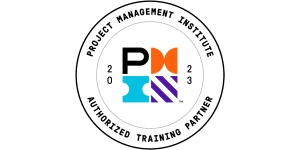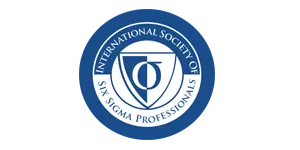Project Resource Management: Six Sigma Approach to Optimizing Project Resources
When resources aren’t properly allocated, tracked, or optimized, even the most promising projects can quickly derail.
Project resource management through a Six Sigma lens transforms how organizations handle their most valuable assets—people, equipment, materials, and budget.
By applying data-driven methodologies and proven optimization techniques, Six Sigma principles elevate traditional resource management from reactive scrambling to strategic deployment.
Key Highlights
- Essential resource planning frameworks
- Six Sigma tools for resource optimization
- Practical allocation techniques that work
- Software solutions for seamless management
What Is Project Resource Management?
Project resource management refers to the process of planning, scheduling, and allocating organizational resources in the most efficient way possible throughout the project lifecycle.
It ensures that the right resources are available at the right time and in the right quantity to complete project activities successfully.
Effective project resource management directly impacts project outcomes, team morale, and the bottom line.
When executed properly, it prevents bottlenecks, reduces costs, and increases the likelihood of delivering projects on time and within budget.
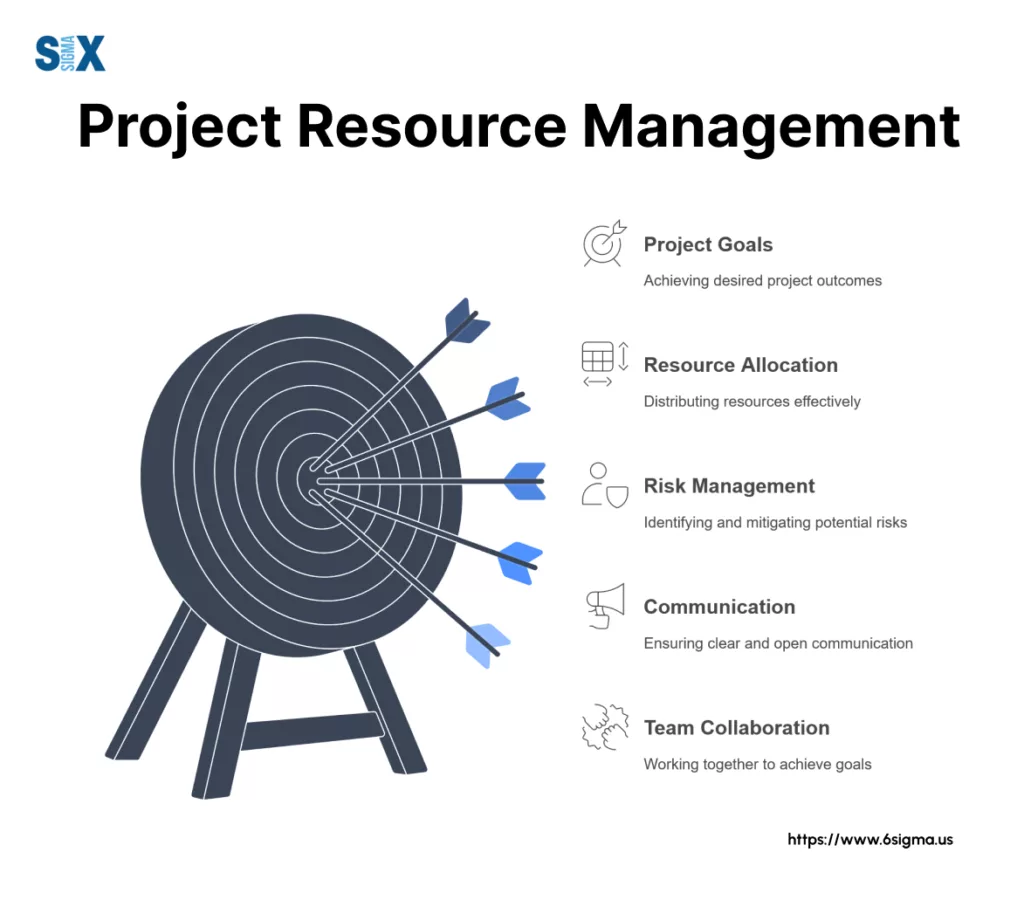
Definition and Scope
Project resource management encompasses identifying, acquiring, and managing all resources needed for project completion.
This includes not just assigning tasks to team members, but also tracking resource utilization, resolving conflicts, and making adjustments as project needs evolve.
The scope extends from initial resource planning during project conception through execution and closing phases.
Resource project management also involves forecasting future needs and ensuring resources aren’t over-allocated across multiple projects.
Types of Project Resources
Projects typically require several categories of resources:
- Human Resources: The team members, specialists, and stakeholders who contribute their time and expertise.
- Physical Resources: Equipment, facilities, materials, and infrastructure needed to complete work.
- Financial Resources: The budget allocated for the project, including contingency funds.
- Time: Often overlooked but critical—the available hours, days, or weeks to complete tasks.
- Information Resources: Documentation, data, intellectual property, and knowledge required.
Core Components of Resource Management
Successful project resources management relies on several key components:
- Resource Planning: Determining what resources are needed, when they’re needed, and in what quantities.
- Resource Estimation: Calculating the amount of each resource required for specific activities.
- Resource Allocation: Assigning resources to specific tasks and project phases.
- Resource Leveling: Resolving conflicts and ensuring resources aren’t overallocated.
- Resource Monitoring: Tracking actual resource usage against planned usage.
- Resource Optimization: Making adjustments to improve efficiency and reduce waste—a core principle in Six Sigma Certification.
- Resource Forecasting: Predicting future resource needs based on current data and trends.
These components work together in a continuous cycle, with feedback loops allowing for adjustments as project conditions change.
The most successful project managers understand that resource management isn’t a one-time activity but an ongoing process requiring regular attention and refinement.
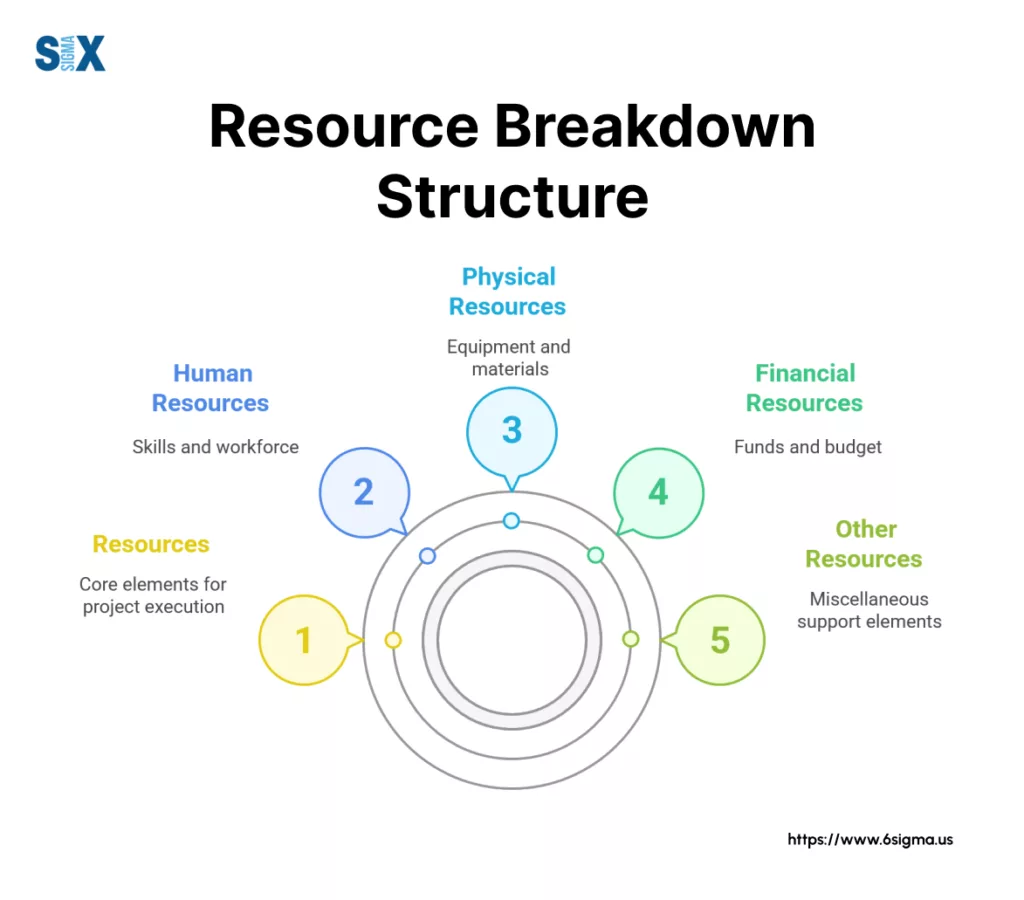
Six Sigma Framework in Project Resource Management
Six Sigma methodologies offer powerful approaches to enhance project resource management processes.
By applying data-driven techniques and statistical analysis, taught within six sigma certification programs, organizations can minimize waste, reduce variations, and optimize resource utilization across projects.
The structured nature of Six Sigma perfectly complements the often chaotic reality of managing project resources.
DMAIC Process Application
The DMAIC framework (Define, Measure, Analyze, Improve, Control) provides a systematic approach to solving resource management challenges:
Define: Resource Requirements
In this initial phase, project teams clearly identify what resources are needed, when they’re required, and the specific capabilities necessary.
This includes documenting resource constraints, stakeholder expectations, and creating detailed resource requirement specifications.
The definition phase establishes clear parameters for project resource management success.
Measure: Resource Metrics
Measurement involves collecting baseline data on resource performance and utilization. Teams track metrics such as resource availability, capacity, utilization rates, and productivity.
This quantitative approach helps establish a factual foundation for resource decisions rather than relying on gut feelings or assumptions.
Analyze: Resource Utilization
During analysis, teams examine resource data to identify inefficiencies, bottlenecks, and root causes of resource problems.
Statistical tools help identify patterns, correlations, and causal factors affecting resource performance. This might include analyzing why certain team members are consistently over-allocated or why specific equipment resources face frequent downtime.
Improve: Resource Optimization
Based on analysis findings, teams implement targeted improvements to resource allocation and utilization.
This might include redistributing workloads, adjusting resource scheduling, implementing new tools, or redesigning resource management processes. The goal is to maximize efficiency while maintaining quality.
Control: Resource Monitoring
The control phase establishes ongoing monitoring systems to maintain improvements and prevent regression.
Teams implement dashboards, regular reviews, and feedback mechanisms to ensure resource management gains are sustained over time.
For deeper understanding of these techniques, consider pursuing a Six Sigma certification like our Six Sigma Green Belt certification program, which provides detailed DMAIC training.
Key Roles and Responsibilities
Effective project resource management processes require clear role definition within the Six Sigma framework:
Project Sponsors
Sponsors provide executive support and remove organizational barriers to resource optimization.
They authorize resource allocation, resolve high-level conflicts, and ensure alignment between project resource needs and organizational strategy.
Black Belts
These Six Sigma experts lead complex resource optimization initiatives. They apply advanced statistical tools to analyze resource utilization patterns and identify improvement opportunities.
Black Belts typically focus on systemic resource management issues affecting multiple projects.
Green Belts
Green Belts manage day-to-day resource optimization activities. They collect and analyze resource data, implement improvements, and monitor resource performance metrics.
They often serve as the bridge between project teams and Six Sigma methodology.
Team Members
Team members provide accurate input on resource requirements and capabilities. They implement resource management processes, report issues, and participate in improvement initiatives.
Their frontline perspective is invaluable for identifying practical resource optimization opportunities.
By integrating Six Sigma methodologies with project resource management, organizations create a data-driven approach to resource optimization that reduces waste, improves predictability, and enhances project outcomes.
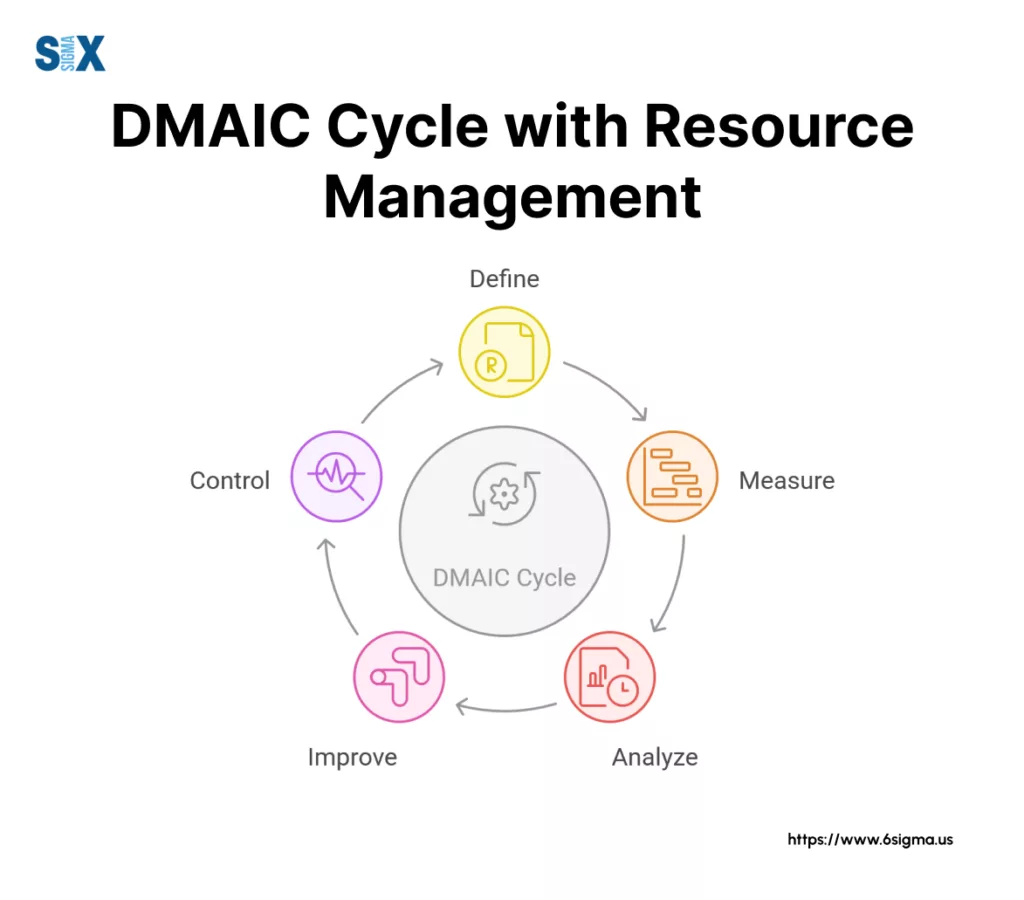
Solve Your Resource Management Challenges
Gain the practical skills taught in our Six Sigma Green Belt certification to drive efficiency and improve project outcomes.

Resource Planning and Estimation
Effective project resource management begins with thorough planning and accurate estimation.
This foundational stage determines how smoothly your project will run and whether you’ll face resource shortages or excesses down the line.
Project management resource planning requires both art and science—combining data analysis with practical experience to forecast resource needs accurately.
Six Sigma Tools for Resource Planning
Six Sigma methodology offers several powerful tools that enhance resource planning precision:
SIPOC Diagrams help identify all suppliers, inputs, processes, outputs, and customers involved in resource utilization. This visualization clarifies which resources are needed at each project stage and who provides them.
Fishbone Diagrams (Ishikawa) identify potential causes of resource constraints or bottlenecks before they occur. Teams can proactively address these issues during planning rather than reactively during execution.
FMEA (Failure Mode and Effects Analysis) helps teams anticipate potential resource failures and develop contingency plans. This risk-based approach is particularly valuable for critical resources where unavailability would severely impact the project.
Voice of Customer (VOC) analysis ensures resource planning aligns with stakeholder expectations and requirements. This prevents the common mistake of planning resources based solely on internal perspectives.
Resource Estimation Techniques
Accurate resource estimation forms the backbone of project resource management. Several techniques help improve estimation accuracy:
Parametric Estimating uses statistical relationships between historical data and variables to calculate resource needs. For example, knowing that similar past projects required 4 developer-hours per function point helps estimate new project requirements.
Three-Point Estimating combines optimistic, pessimistic, and most likely scenarios to create more realistic resource forecasts. This technique acknowledges the uncertainty inherent in resource planning.
Bottom-Up Estimating builds resource estimates by aggregating detailed estimates from individual work packages. While time-consuming, this method typically produces the most accurate results.
Expert Judgment leverages the knowledge of experienced team members and subject matter experts. When historical data is limited, structured expert input becomes invaluable.
Creating Resource Management Plans
A robust project resource management plan documents how resources will be estimated, acquired, managed, and eventually released. Key components include:
Resource Breakdown Structure (RBS) categorizing all required resources by type, department, or function.
Responsibility Assignment Matrix (RACI) clarifying who is Responsible, Accountable, Consulted, and Informed regarding resource decisions.
Resource Calendars showing availability of key resources, accounting for vacations, holidays, and other commitments.
Resource Histograms visualizing resource loading over time to identify periods of over or under-allocation.
Conflict Resolution Procedures outlining how resource conflicts will be addressed when they inevitably arise.
When developing these plans, a root cause analysis training helps teams systematically identify and address underlying factors that might affect resource availability or performance, rather than just addressing symptoms.
The most effective resource management plans remain flexible, allowing for adjustments as project conditions evolve while maintaining alignment with strategic objectives.
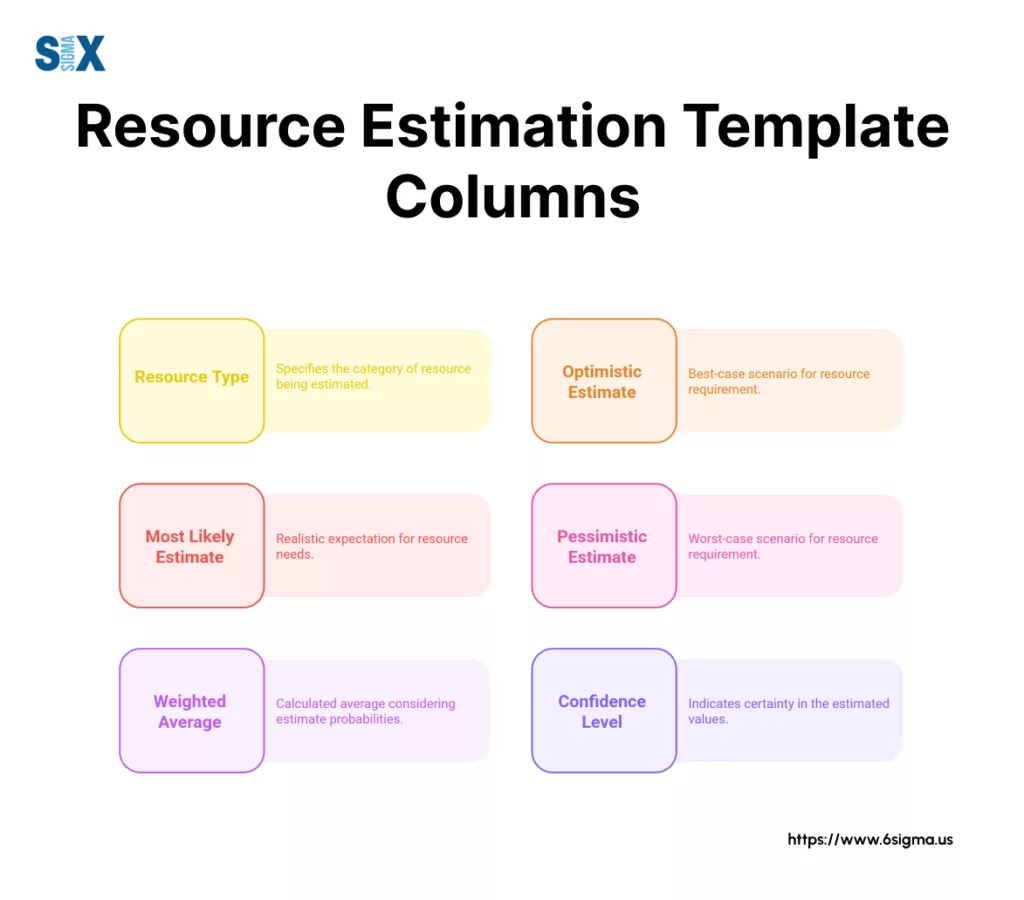
Resource Allocation and Optimization
Once resources have been identified and estimated, the next critical phase in project resource management involves allocating these resources effectively and optimizing their usage throughout the project lifecycle.
This stage directly impacts project timelines, budgets, and team morale.
Lean Principles in Resource Allocation
Understanding the Fundamentals of Lean offers valuable principles that enhance resource allocation in project management:
Value Stream Mapping identifies which activities truly add value and which create waste. By mapping the flow of resources through project activities, teams can eliminate non-value-adding steps that consume resources unnecessarily.
Just-in-Time (JIT) allocation ensures resources are available exactly when needed—not too early, which ties up resources that could be used elsewhere, and not too late, which delays project progress. This approach minimizes waste and improves resource efficiency.
Pull Systems allow downstream activities to signal when they need resources, rather than pushing resources according to a rigid schedule. This responsive approach prevents resource bottlenecks and reduces idle time.
Standard Work establishes consistent procedures for resource allocation, making the process more predictable and less prone to errors. Standardization also makes it easier to identify improvement opportunities.
Teams applying the Fundamentals of Lean often pair these principles with Six Sigma to create hybrid efficiency models.
Resource Leveling Techniques
Resource leveling project management addresses the common problem of uneven resource distribution. These techniques help smooth out resource demands:
Critical Path Adjustment modifies the sequence of activities to better distribute resource requirements while still meeting project deadlines. This might involve delaying non-critical activities to free up resources for critical path tasks.
Resource-Limited Scheduling prioritizes resource constraints over time constraints, potentially extending project duration to avoid resource over-allocation. This approach is necessary when resources are fixed and cannot be supplemented.
Fast-tracking executes certain activities in parallel rather than sequentially, changing the resource demand pattern. This technique can help resolve resource conflicts without extending the schedule.
Skill substitution uses alternative resources with similar capabilities when preferred resources are unavailable. This flexibility helps maintain progress despite resource constraints.
Resource Smoothing Methods
Resource smoothing focuses on minimizing fluctuations in resource usage while maintaining the original project end date. Effective resource allocation in project management employs these smoothing methods:
Activity splitting breaks activities into smaller segments that can be paused and resumed, allowing resources to be temporarily reassigned to higher-priority tasks. This creates a more flexible resource allocation pattern.
Resource calendars adjustment modifies work schedules to better align with resource availability patterns. This might involve scheduling intensive work during periods of high resource availability.
Resource constraints analysis identifies and addresses bottlenecks by reallocating flexible resources to support constrained resources. This targeted approach focuses optimization efforts where they’ll have the greatest impact.
Buffer management strategically places time and resource buffers at critical points in the project to absorb variations without disrupting the overall schedule. This creates breathing room for resource allocation adjustments.
The goal isn’t perfect resource utilization—which is rarely achievable—but rather the optimal balance between resource efficiency and project effectiveness.
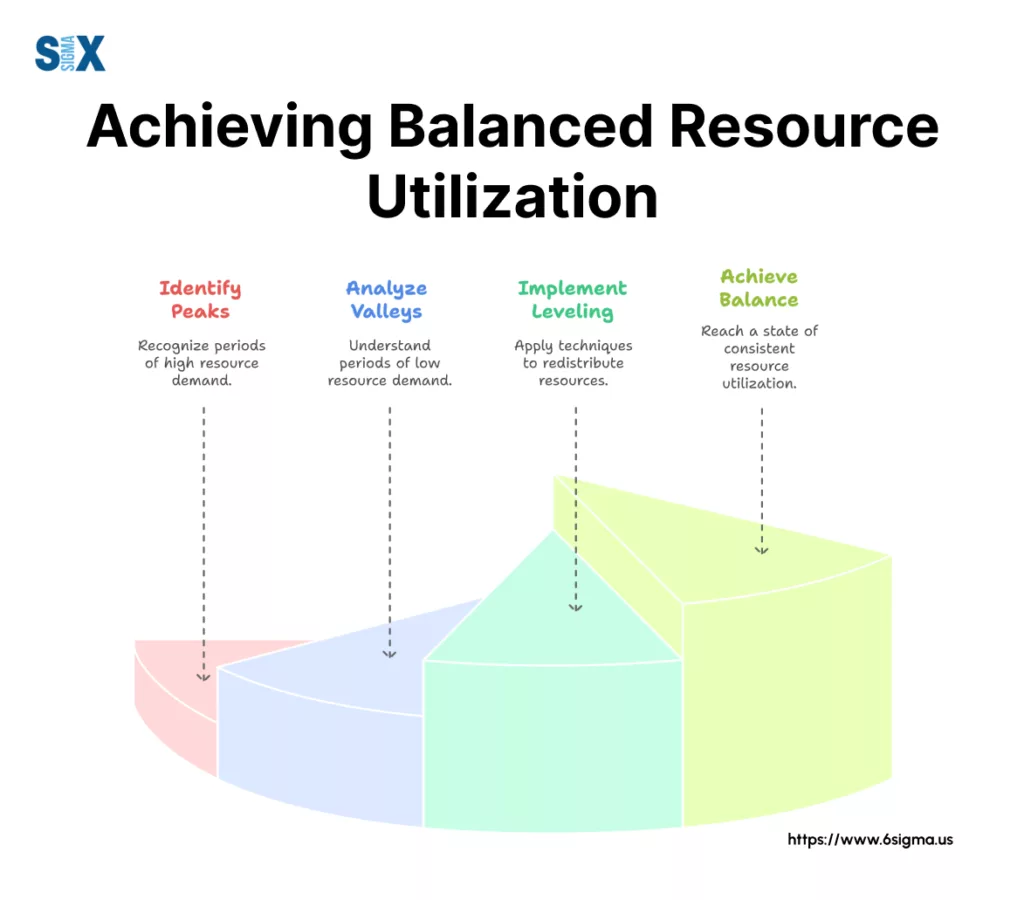
Monitoring and Control
The monitoring and control phase of project resource management transforms plans into reality by tracking actual resource usage against forecasts and making necessary adjustments.
Without robust monitoring, even the most carefully crafted resource plans can quickly become irrelevant as project conditions evolve.
KPIs and Metrics
Effective project resource management relies on tracking the right metrics. Key performance indicators help project managers assess resource health and identify potential issues before they impact project outcomes:
Resource utilization rate measures the percentage of available time that resources are productively engaged. Target ranges typically fall between 70-85%, as 100% utilization leaves no flexibility for unexpected work.
Resource capacity tracks the maximum available hours or units for each resource type, helping managers understand their constraints and capabilities.
Planned vs. actual usage compares estimated resource requirements against real consumption, highlighting estimation accuracy and potential process improvements.
Resource burndown charts show remaining resource availability against remaining work, providing early warning of potential shortfalls.
Resource cost variance identifies differences between budgeted and actual resource costs, triggering investigation when thresholds are exceeded.
Performance Tracking
Tracking resource performance requires both tools and processes to collect, analyze, and visualize resource data:
Regular status meetings provide qualitative insights into resource challenges that might not be captured in metrics alone. These forums allow team members to raise concerns about resource constraints.
Time-sheet systems capture actual resource usage at the task level, feeding data into broader project resource management systems.
Resource dashboards consolidate key metrics into visual displays that highlight trends and exceptions requiring attention.
These dashboards should be accessible to all stakeholders with resource management responsibilities.
Milestone Reviews assess resource performance at key project points, allowing for more substantial adjustments to resource allocation strategies if needed.
Corrective Actions
When monitoring reveals resource issues, project managers must implement appropriate corrective actions:
Resource reallocation shifts resources from lower to higher priority tasks when constraints emerge, ensuring critical path activities remain on schedule.
Scope modification may be necessary when resource constraints cannot be resolved through reallocation. This might involve reducing deliverables or extending timelines.
Resource acquisition addresses capability gaps by bringing in additional resources, whether through hiring, contracting, or internal transfers.
Process improvement targets inefficiencies identified through monitoring, streamlining activities to reduce resource requirements.
For advanced techniques in monitoring resource performance and implementing data-driven corrective actions, many organizations benefit from Six Sigma Black Belt Certification, which provides deeper statistical analysis methods.
The most effective project resource management systems create feedback loops where monitoring insights inform future planning, creating a cycle of continuous improvement in resource estimation and allocation practices.

Master Advanced Techniques For Monitoring Resource Performance
Elevate your analytical skills to tackle systemic resource issues with our in-depth Six Sigma Black Belt Certification.
Best Practices and Challenges
Mastering project resource management requires understanding both industry-specific nuances and universal principles.
Organizations that excel in resource management typically outperform competitors through better efficiency, higher team morale, and more consistent project outcomes.
Industry-Specific Applications
Different sectors face unique resource management challenges that require tailored approaches:
In Construction, resource management focuses heavily on equipment scheduling, material delivery timing, and specialized labor coordination. Weather dependencies and regulatory inspections add complexity to resource planning.
Software development teams often deal with the challenge of shared technical specialists across multiple projects.
Sprint-based methodologies require flexible resource management systems that can adapt to changing priorities.
Healthcare projects must balance clinical staff availability with patient care obligations. Resource planning typically works around clinical schedules rather than dictating them.
Manufacturing environments emphasize production line efficiency and equipment utilization. Resource management often integrates with maintenance schedules to minimize downtime.
Professional services firms track billable utilization as a primary metric, with resource management directly impacting profitability. Client expectations frequently drive resource allocation decisions.
Common Pitfalls
Even experienced project managers encounter these resource management challenges:
Over-allocation occurs when the same resources are assigned to multiple concurrent tasks beyond their capacity. This creates unrealistic schedules and leads to burnout.
Inadequate skills assessment results in assigning resources to tasks they cannot effectively complete, causing quality issues and delays.
Failure to account for administrative time leads to overly optimistic productivity estimates. Most resources cannot dedicate 100% of their time to project tasks.
Poor communication between project managers creates resource conflicts when multiple projects draw from the same resource pool without coordination.
Ignoring resource dependencies happens when planners fail to recognize that certain resources cannot function effectively without others being available simultaneously.
Success Strategies
Organizations can improve their project resource management system by implementing these proven strategies:
Establish a resource governance framework that clearly defines roles, responsibilities, and decision rights for resource allocation across the organization.
Implement rolling wave planning to detail near-term resource needs while maintaining flexibility for future requirements as they become clearer.
Create resource pools of similar skill sets to increase flexibility and reduce dependency on specific individuals.
Develop contingency plans for critical resources, identifying backups or alternatives that can be deployed if primary resources become unavailable.
Standardize resource request processes to ensure proper evaluation and prioritization of competing demands.
Invest in proper training, such as pursuing a certification in six sigma, so that all stakeholders understand resource management principles and their role in the process.
Conclusion
Effective project resource management stands as a critical differentiator between successful and struggling projects.
By implementing structured approaches to planning, allocating, and monitoring resources, organizations can dramatically improve project outcomes while reducing waste and team burnout.
The integration of Six Sigma methodologies with traditional project management practices offers powerful tools for optimizing resource usage.
From DMAIC process applications to lean resource allocation principles, these approaches provide data-driven frameworks for continuous improvement.
To implement these concepts in your organization, start by assessing your current resource management maturity, select appropriate tools and techniques based on your specific challenges, and commit to gradual improvement through consistent application of best practices.
Remember that resource management is not a one-time effort but an ongoing discipline that evolves with your organization’s needs.
SixSigma.us offers both Live Virtual classes as well as Online Self-Paced training. Most option includes access to the same great Master Black Belt instructors that teach our World Class in-person sessions. Sign-up today!
Virtual Classroom Training Programs Self-Paced Online Training Programs

